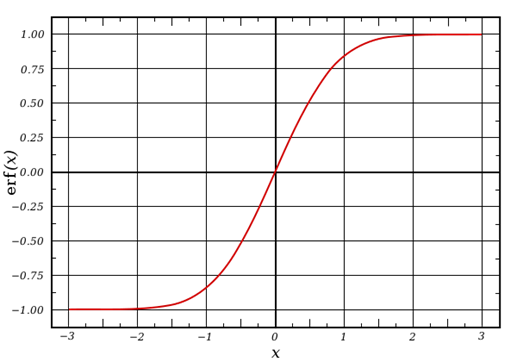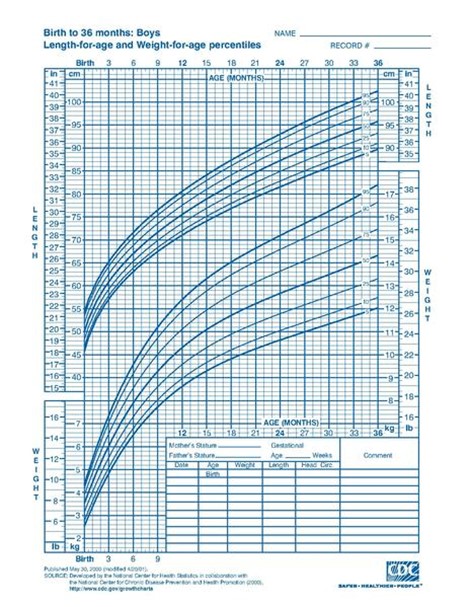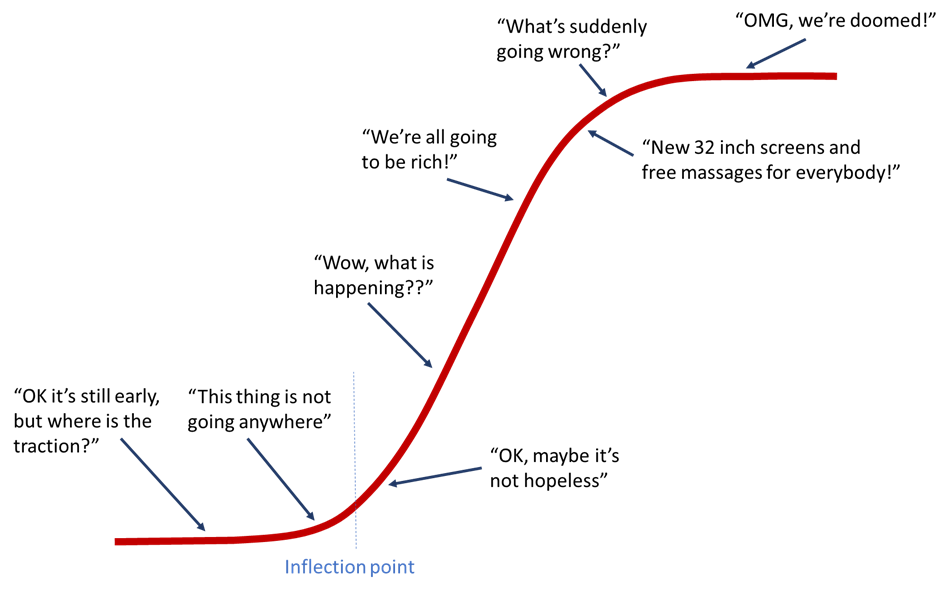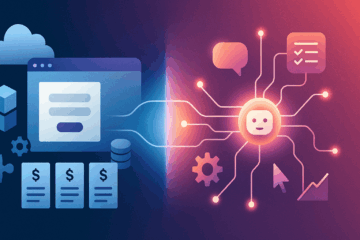The world of entrepreneurship is full of buzzwords. We all want to found the next disruptive game-changing hot startup, leveraging our first-mover advantage in deep tech by thinking outside the box, just before pivoting (in an agile way!) after our A/B tests showed concerns with our UX and product market fit, then finally putting our early adopter pick-up speed and monetization unit economics on viral escape velocity, earning us that unicorn-valuation series C term sheet. Don’t we?
With all that noise, it’s very easy to lose sight of the truly important concepts. One of the most important ones, maybe the most important one for startup leadership teams, is the phenomenon of the S-curve. It determines almost everything in innovation, and while it looks simple, it is incredibly hard to grasp in practice.
Sometimes in startups, things are going way too slowly. You might hear concerns like:
- We don’t know if market timing is right. It looks like we are way too early.
- Customers are not adopting our product as quickly as we had hoped.
- Product development is taking way too long. We are behind on our roadmap.
- Why are our salespeople taking too long to ramp up productivity?
- Why do these VCs take so long to get back to us?
And just a few weeks later you might hear this:
- How are we going to serve all these new customers that just signed up?
- We can’t hire fast enough.
- Our new product features are way ahead of the plan, and sales is struggling to explain them.
- Our cash is running low because we can’t finance all these new deals we just closed.
- How are we going to pick from the five VC term sheets we just got?
This kind of rollercoaster is perfectly normal. Timing in a startup changes abruptly and suddenly all the time, in ways that are hard to grasp.
What’s behind this? More often than not, you’re being surprised by developments that follow a non-linear S-curve. This is what an S-curve looks like:

(Source)
Most of the things you are going to encounter in a fast-moving innovative environment such as a startup follows this kind of pattern. First things go very slowly, then they go really fast, then they slow down again quite suddenly.
Why is it so hard to intuitively grasp this? Humans are really bad at understanding non-linear growth. The main reason is probably that we’re used to fairly linear growth in nature. Consider this growth chart for kids age 0 to 36 months:

(Source)
The growth path is almost exactly a straight line after a quick initial growth spurt. Most organic lifeforms follow this kind of near-linear, very gradual growth. We intuitively expect new things to first grow quite quickly before settling in on a constant linear growth path, and that’s what we unconsciously expect our startups to be like.
S-Curves behave quite differently. At the bottom of an S-curve it feels like not much is happening at all. That’s when startup leaders (and their employees) feel frustrated about slow progress, bordering on feelings of wanting to give up because this thing is clearly not going anywhere.
But then things start to pick up. Once you cross an inflection point, suddenly things start going wild. Growth kicks in and keeps speeding up. Everybody scrambles to keep up with the newfound success. Often money is raised and investments are made, people are hired and offices are rented, typically under the assumptions that things will continue to grow at this pace.
And then, after a while, something seems to go wrong. It’s just subtle at the beginning, maybe orders not coming in at quite the same pace, maybe engineering velocity slowing down just a bit. Then, suddenly, growth grinds nearly to a halt. Everybody is asking: What did we do wrong? How did we kill the golden goose?

The answer is: That’s just the way things go in innovation. People and teams reach a plateau in their productivity. Market and specific customer segments get saturated. Technological progress tops out. It feels brutal after the growth spurt that typically preceded this sudden slowdown.
Almost everything in a startup follows this pattern, for instance:
- Overall market development (for example, we’re currently seeing a flattening of innovation in mobile)
- Customer adoption
- Product usage by individual customers
- Sales productivity
- Developer productivity
- Investor interest
What makes things worse: Often you are dealing with overlapping s-curves that obscure what is really going on. For example, maybe sales growth is looking fantastic because your two best salespeople are at steepest point of their own rapid productivity growth. Unfortunately, the rest of your sales team is still stuck in the flatlands at the beginning of the S-curve. And after a couple of months, tremendous sales traction turns into a bust as your top people start flattening out and your newer sellers are struggling to get beyond the inflection point.
What’s the solution? Leadership teams need to learn two essential skills:
1. Deeply understand S-curves (which is not intuitive, but takes an intellectual effort) and try to map out realistically where you stand on any relevant curve. Then adapt your perception of the world accordingly.
2. Set up the next S-curve early enough. For example, starting to think about your next product generation when sales for the first one flattens out is way too late. You want to start it when things are going really great. That’s unfortunately hard to do because in the steep phase of the s-curve everybody thinks that things will go like this forever and are reluctant to invest into an unknown future.
Bottom line: Understanding non-linear S-curve growth and acting on these insights is very difficult. But it is one of the most important skills if you want to anticipate innovative markets, create new products and lead a startup or innovation team to success.


